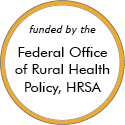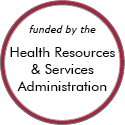Rural Project Examples: Chronic disease management
Evidence-Based Examples
Chronic Disease Self-Management Program
Updated/reviewed November 2025
- Need: To help people with chronic conditions learn how to manage their health.
- Intervention: A small-group 6-week workshop for individuals with chronic conditions to learn skills and strategies to manage their health.
- Results: Participants have better health and quality of life, including reduction in pain, fatigue, and depression.
Effective Examples
Kentucky Homeplace
Updated/reviewed October 2025
- Need: Rural Appalachian Kentucky residents have deficits in health resources and health status, including high levels of cancer, heart disease, hypertension, asthma, and diabetes.
- Intervention: Kentucky Homeplace was created as a community health worker initiative to provide health coaching, increased access to health screenings, and other services.
- Results: From July 2001 to June 2025, over 202,000 rural residents were served. Preventive health strategies, screenings, educational services, and referrals are all offered at no charge to clients.
The Pacific Care Model: Charting the Course for Non-communicable Disease Prevention and Management
Updated/reviewed October 2025
- Need: The U.S. Associated Pacific Islands (USAPI) needed an efficient, effective, integrated method to improve primary care services that addressed the increased rates of non-communicable disease (NCD), the regional-specific phrase designating chronic disease.
- Intervention: Through specialized training, multidisciplinary teams from five of the region's health systems implemented the Chronic Care Model (CCM), an approach that targets healthcare system improvements, uses information technology, incorporates evidence-based disease management, and includes self-management support strengthened by community resources.
- Results: Aimed at diabetes management, teams developed a regional, culturally-relevant Non-Communicable Disease Collaborative Initiative that addresses chronic disease management challenges and strengthens healthcare quality and outcomes.
Meadows Diabetes Education Program

Updated/reviewed September 2025
- Need: To provide diabetes care and education services to those in rural southeast Georgia.
- Intervention: Diabetes outreach screening, education, and clinical care services were provided to participants in Toombs, Tattnall, and Montgomery counties. The program is no longer active.
- Results: Patients successfully learned self-management skills to lower their blood sugar, cholesterol, and blood pressure.
Community Health Worker-based Chronic Care Management Program
Updated/reviewed August 2024
- Need: Improve healthcare access and decrease chronic disease disparities in rural Appalachia.
- Intervention: A unique community health worker-based chronic care management program, created with philanthropy support.
- Results: After a decade of use in attending to population health needs, health outcomes, healthcare costs, in 2024, the medical condition-agnostic model has a 4-year track record of financial sustainability with recent scaling to include 31 rural counties in a 3-state area of Appalachia and recent implementation in urban areas.
The Health-able Communities Program

Updated/reviewed August 2024
- Need: Expand healthcare access for the more remote residents of 3 frontier counties in north central Idaho.
- Intervention: With early federal grant-funding, a consortium of healthcare providers and community agencies used a hybrid Community Health Worker model to augment traditional healthcare delivery services in order to offer a comprehensive set of health-related interventions to frontier area residents.
- Results: With additional private grant funding, success continued to build into the current model of an established and separate CHW division within the health system's population health department.
Other Project Examples
Pacific AIDS Education and Training Center-Nevada

Updated/reviewed April 2025
- Need: To improve and increase prevention and care services for HIV, STDs, hepatitis C, and other infectious diseases.
- Intervention: PAETC-NV provides clinical and didactic trainings, conferences, technical assistance, capacity building, webinars, and other services to providers and healthcare organizations statewide.
- Results: In 2024, PAETC-NV trained more than 1,800 healthcare providers across Nevada to increase clinical capacity in the care, screening, and prevention of HIV, other sexually transmitted diseases, and hepatitis C.
ASPIN's Certified Recovery Specialist Program


Updated/reviewed September 2022
- Need: Improved approach in addressing the behavioral health and primary care disparities of Indiana's rural counties.
- Intervention: A network was established that trained community health workers (CHWs) to be certified health insurance enrollment navigators and provide mental health services.
- Results: This year, ASPIN trained 230 CHWs, cross-trained 70 behavioral health case managers as CHWs, and 35 individuals in the Indiana Navigator Pre-certification Education.
Boone County Health Center Pulmonary Rehabilitation Program
Updated/reviewed June 2022
- Need: Evidenced-based intervention to improve function and quality of life for patients with chronic obstructive pulmonary disease and other chronic lower respiratory conditions.
- Intervention: Pulmonary rehabilitation program implementation in 1989.
- Results: Compared to a national average of only about 3% of referred Medicare beneficiaries actually enrolling in pulmonary rehabilitation, 60% of the program's referred patients enroll. Averaging around 15 patients/year completing the program, a large combined cardiac and pulmonary rehabilitation maintenance population averages 8,000 visits/year.
Avita Health System Comprehensive Cardiology Program
Added April 2021
- Need: Population health approach to decreasing area deaths from cardiovascular disease.
- Intervention: A health system-level investment in level II cardiac catheterization services and the required specialized cardiology workforce.
- Results: Since August 2018, the Avita Health System in north central Ohio has provided local cardiovascular services that have decreased hospital transfers, increased care coordination, and provided education and prevention activities that, with time, will impact population health cardiovascular outcomes.
For examples from other sources, see:
